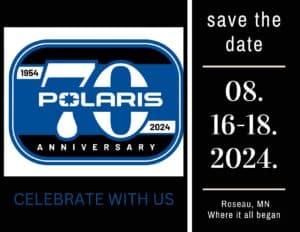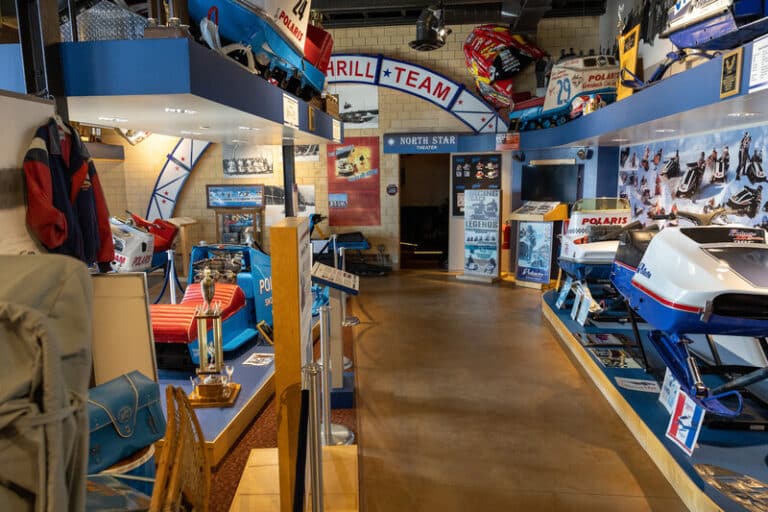Showcasing the design of the Comet, Super Pacer, and Mustang Vintage Polaris snowmobile from the 1960s
The first Polaris snowmobile was designed in Roseau, MN in 1954. By the 1960s, the founders had racing in mind. Their machines were becoming faster and the design was changing to a more streamlined design. Testing was on the taking place and development was creating a new machine with racing on the forefront. It was exciting times that could make the company or break the company. The outcome was three models: the Comet, Super Pacer, and Mustang. These are the three legendary Polaris snowmobiles of the 1960s
1963 Polaris Comet | Vintage Polaris Snowmobiles
http://polaris.com/en-us/history-timeline/ The Polaris Comet, introduced in 1963, was a light, front-engine snowmobile designed to compete with Bombardier’s Ski-Doo, Polaris’s main rival.
The first sled built for racing was the legendary Polaris Snowmobile known as the Comet. It was tested extensively on the glacier fields of Mount McKinley before production, but it never gained favor with the buying public. It passed every test on the hard-packed surface of the glacier, but when it came to performance in everyday use in the snowbelt, it was a major failure.
“As David Johnson, one of the three founders of Polaris said about the Comet, “There were only three things wrong with the sled. The engine would not run, the clutch would not hold up and the track would not go in the snow.”
The Comet was expected to gain favor with the buying public because of its compact size and versatility. Most sleds up to this point had been considered workhorses, but the Comet was sporty enough to be considered as a recreational vehicle. It also had year-round potential because the skis could be replaced with wheels.
However, the Comet suffered from multiple design flaws that emerged only after it hit the market. The Comet was the first Polaris sled built with the engine up front. It was expected to be a significant change for the company, but it turned out to be a disaster.
The Comet was recalled for extensive reworking, and the sleds were refitted with rear engines and sold the next season as the 1965 Super Pacer.
The 1964 Polaris Super Pacer Snowmobile
The Comet’s failure was a turning point for Polaris Industries, and it marked the first notable failure in the company’s history.
Polaris stood behind the product, but the Comet failure was big enough to bankrupt the company. Allan Hetteen would not let that happen. He saw to it that vendors got paid, he kept employees working, and he faced down the creditors. He knew that if he could keep the operation going the next new model, the 1965 Mustang, would be everything that the Comet was not. The Mustang would work and position Polaris for the future.
It was a tough year. Hetteen could have sold off the company for 10 cents on the dollar.
He felt the pressure, telling a fellow Polaris executive, “I feel like a man standing alone in a forest with the trees all cut down around him.”
The Polaris employees displayed incredible loyalty. Through their efforts and sacrifices, the group pulled together and contributed to the survival of the company.
Polaris was in dire need of a product that would breathe new life into the operations.
The new snowmobile model the R&D was working on would either make the company or break it.
In 1964 a new proto-type machine was being developed by several Polaris employees including Vernon (Bud) Johnson and Albin Erickson.
Vernon (Bud) Johnson
“Vernon (Bud) Johnson was the Chief Engineer and headed up the Research and Development staff at Polaris who was responsible for the design engineering, the quality control, and the blueprinting departments. The catchy design of the Mustang and the Colt are the result of months of work on the part of the Research and Development Department.” as quoted in the company newsletter.
Albin Erickson
Albin started working for Hetteen Hoist and Derrick, which eventually became Polaris Industries. He advanced to Chief Engineer of Research and Development. During this time Albin designed a variable-speed centrifugal clutch, which became the standard for the snowmobile industry.
During the development of the new model, Allan Hetteen called a life-long friend Carl Wahlberg, who had helped to secure financing during Polaris’s early years, having established the company’s first distributorship in the western United States. Hetteen asked Wahlberg to try out the company’s new, post-Comet snowmobile.
Carl Wahlberg, (left) on a Comet, outfitted with a different track system, and Allan Hetteen, test a prototype Mustang at West Yellowstone.
The new machine came with five power-plant choices (from six to 14 horsepower) and could reach speeds of up to 35 miles per hour. It had a fully molded rubber track, leaf spring front suspension, and a new clutch that Polaris designed and built itself.
The 1965 Polaris Mustang Snowmobile
As this project was in the works, ongoing development and testing of the current product continued. The company and employees were always looking for venues to highlight the snowmobiles. This is still true today: development and engineering drive the company to the top in the Powersports industry. Take a moment to follow Polaris across its 70 years from 1954 to 2024.

Countdown to the Polaris 70th Celebration
To learn more about the history of Polaris, visit the Polaris Experience Center in Roseau, MN
Come celebrate with us, book your lodging now
Explore lodging options now and make your next adventure unforgettable!
Writing and History by Sinnamon Krings and Camen Przekwas. History provided by Bob and Carmen Prezkwas, Mike Hetteen, Randy Larson, David Lee. Photos from Roseau Historical Society, Polaris Newsletters, and private collections. All Rights Reserved

